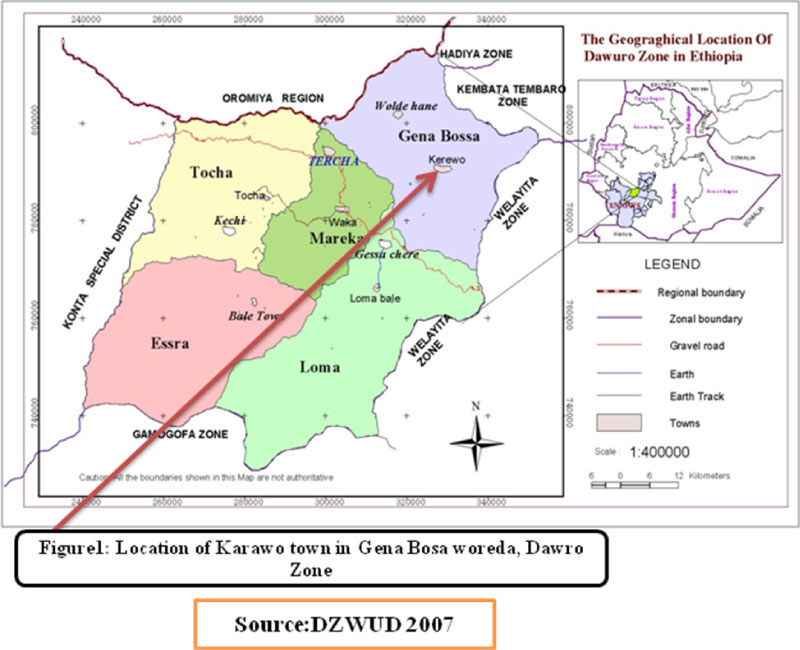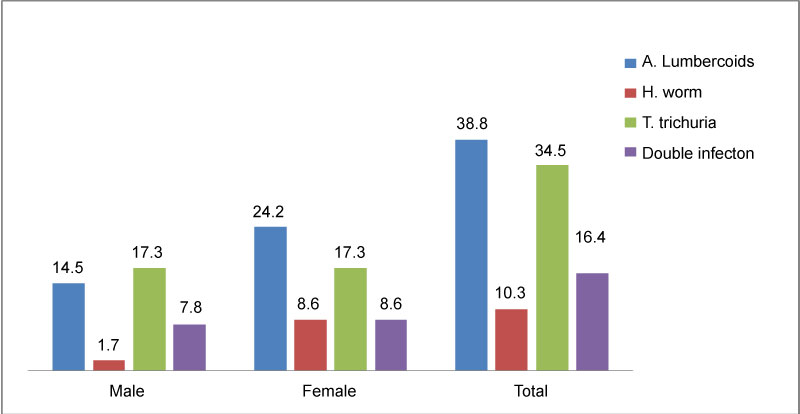Soil-Transmitted Helminthes (STH) infection is a major public health problem among school-aged children in developing countries. In Ethiopia, school aged children have been identified as high risk group of population to be infected with Soil Transmitted Helminthes. Effective prevention and control of STH infection requires identification of risk factors among high risk groups. Therefore, the aim of this study was to assess the prevalence and determinants of Soil Transmitted Helminthes infection among primary school children in Kerewo Town, Gena Bossa Woreda, Ethiopia.
Cross-sectional study was conducted in Kerewo Town, Ethiopia. The data was collected using pre-tested and structured questionnaires. Simple random sampling technique was used. Data analysis was done by SPSS for Windows Version 20.0. Bivariate and Multivariate logistic regressions analyses were conducted. P-value < 0.05 was used to declare statistically significant variables.
About 303 (97.7%) of the study subjects were participated in the study. Above one-third (38.3%) of the study participants were tested positive for at least one of the STH species. Lumbricoides (42.1%) was the predominant parasite followed by Hookworms (37.4%) and T. Trichiura (11.2%). Lack of private latrines (AOR = 4.12, 95% CI: 1.64, 3.37), not wearing shoes always (AOR = 1.80, 95% CI: 1.01, 3.23), age of children (5 to 10 years) (AOR = 2.43, 95% CI: 1.42, 4.16) and not knowing causative agents of STH infection (AOR = 2.60, 95% CI: 1.37, 4.93) were found to be determinants of Soil Transmitted Helminthes Infections.
Lack of private latrines, not wearing shoes always, age of children (5 to 10 years) and not knowing causative agents of STH infections were found to be major determinants of STH Infections. Therefore; public health policy makers and stakeholders working in the area should focus their intervention against STH infections on integrated control programs including regular health education on children's shoes wearing habits, raising awareness of school children and their families on STH infections and promoting private latrines in every household.
Determinants, Soil-Transmitted Helminthes, Kerewo Town, Ethiopia
AOR: Adjusted Odds Ratio; SNNPR: Southern Nations Nationalities and Peoples' Region; SPSS: Statistical Package for Social Sciences; STH: Soil Transmitted Helminthes
Soil-Transmitted Helminthes (STH) refers to a group of parasites that live in the soil in warm and humid climates and are transmitted to humans by faecally contaminated soil. Major STHs to humans are Ascaris lumbricoides (Roundworm), Trichuris Trichiura (Whipworm), and Hookworm (Necator americanus and Ancylostoma duodenale) [1,2].
Globally, 2 billion people are infected with soil-transmitted helminthes. STH infections are most prevalent in tropical and sub-tropical regions of the developing world where adequate water and sanitation are lacking [1,3]. In Sub-Saharan Africa, STHs infects over 90 million school children [2,4].
Children are important high risk group for soil transmitted helminthes. They are largely affected with STH infection which negatively affects their physical growth, intellectual development and resistance to other diseases that are contributing significantly to school absenteeism. Furthermore, a large proportion of school children are likely not to be aware of the need for good personal and environmental hygiene and are continuously being exposed to contaminated soil and water [2,5,6].
A national school health and nutrition survey done in 2005-2006 revealed that overall national prevalence of any soil transmitted helminthes infection was 29.8% with variable degree of prevalence among regions. Accordingly, SNNPR and Gambella Region contributed the highest prevalence of STH infections i.e. 51% each. Infection of Ascaris lumbricoides was the most prevalent (23.2%), followed by Hookworms (9.1%) and Trichuris Trichiura (7.4%) [7].
There was no prior research conducted in the study area on STH infections. Due to lack of data about STH infection in the study area there has not been deworming program in Gena Bossa Woreda. Therefore, it is important to assess the prevalence and determinants of STH infection in Kerewo Town, Ethiopia.
The study was conducted in Kerewo Town from Aug 05-28/2018. Kerewo Town is the capital town of Gena Bossa Woreda in Dawuro Zone, Ethiopia (Figure 1). It is located 578 KM Southwest of Addis Ababa. It has one functional health center and two health posts. It has four governmental primary schools with total of 3262 school children and 49 teaching sections within a four compound. It has an estimated population of 17,891 (Projected from 2015 National Census).
 Figure 1: Location of Karawo town in Gena Bosa Woreda, Dawro Zone. View Figure 1
Figure 1: Location of Karawo town in Gena Bosa Woreda, Dawro Zone. View Figure 1
Cross sectional study was conducted.
Inclusion criteria: Primary school children who were in age group 5-14 years old.
Exclusion criteria: Children who were clinically ill and treated with anti-helminthes drugs within 2 weeks before the study.
The sample size was calculated using single population proportion formula. The prevalence of STH Infections 27.9% among primary school children of Libo-Kemkem District, Northwest Ethiopia [8], 5% margin of error, 95% confidence level were considered. For the source population was < 10,000, the population Correction formula was applied. Finally, 10% non-response rate was considered. Hence, the total sample size was calculated to be 310.
Questionnaires were prepared in English and translated into the local language (Dawurot'uwa) & vice versa. Pre-test was conducted on 5% of the sample. Data collectors were given short training on data collection methods. Close supervision was conducted throughout the data collection. Data entry and analysis was conducted carefully.
Data was collected using structured questionnaires. Three BSc degree holder public health professionals and three nurses were participated in the data collection. Two supervisors participated. Short orientation was given to the data collectors and supervisors.
Data was analyzed by SPSS windows version 20. Frequencies and percentages of different variables were computed to summarize the data. Bivariate logistic regression model was fitted as a primary method of analysis. Finally, P-Value ≤ 0.05 in multivariate analysis was used to declare statistically significant variables.
The Institutional Review Board (IRB) of Jimma University approved this study. The participants were well informed about the purposes of the study, and oral consents were obtained accordingly. The participants' rights to refuse or withdraw from participating in the study and confidentiality issues were considered.
Neglected tropical diseases: A group of diseases that historically has been overlooked.
Soil-transmitted helminthes: Is a term referring to a group of parasitic diseases caused by nematode worms that are transmitted to humans by faecally contaminated soil.
School-age children: Children aged between 5 and 14 years who may or may not be enrolled in School.
School children: Children aged between 5 and 14 years who are enrolled in school.
School-based deworming: Periodic drug treatment for children in schools based on prevalence to tackle STH infections [2].
Out of 310 sampled primary school children, 303 students participated in the study with the overall response rate of 97.7%. Majority of them, 176 (58.1%), were females and 7 participants were excluded from analysis due to insufficient stool samples obtained.
The children's age ranges from a minimum of 5 years to 14 years with mean age of 10 (± 2.6) years. Two hundred thirty (75.9%) of children's care givers were females. Among the care givers 130 (42.9%) were housewives followed by government workers 51 (16.8%), merchants 41 (13.5%) and private employed 36 (11.9%) (Table1).
One hundred sixteen (38.3%) of the children became positive for at least one of the soil transmitted helminthes species. Besides, A. lumbricoides was the predominant parasite (38.8%) followed by T. trichiura (34.5%). Female children were more infected by STH infections (Figure 2).
 Figure 2: Prevalence of STH among school children, Kerewo Town, Ethiopia, Aug 2018. View Figure 2
Figure 2: Prevalence of STH among school children, Kerewo Town, Ethiopia, Aug 2018. View Figure 2
Multivariate logistic regression analysis revealed that lack of private latrines, not wearing shoes always, age of children (5 to 10 years) and not knowing causative agents of STH infections were found to be major determinants of STH Infections.
School children aged 5 to 10-years-old were two times (AOR = 2.43, 95% CI = 1.42, 4.16) more likely to have STH infections than those aged 11 to 14-years-old. Besides, school children who wear shoes sometimes/not at all wear/ were nearly two times (AOR = 1.80, 95% CI = 1.01, 3.23) more likely to be infected with STH than children who wear shoes always.
Furthermore, school children who do not have a private latrine were four times (AOR = 4.12, 95% CI = 1.64, 3.37) more likely to have STH infection as compared to those who have private latrines (Table 2).
Table 1: Socio-demographic characteristics of school children, Kerewo Town, Ethiopia, Aug 2018. View Table 1
Table 2: Factors associated with STH infection among school children, Kerewo Town, Ethiopia, Aug 2018. View Table 2
The current study revealed that the prevalence of STH infections among school children was 38.3%. This finding was larger as compared to the study findings from Libo-Kemkem District, Northwest Ethiopia [9] and Umolante District, SNNPR Ethiopia [8]. In contrast, the overall prevalence in the current study was lower than the findings of studies conducted in Jimma Zone, Ethiopia [10] and in Nigeria [11]. The differences among the study findings might be due to differences in living standards and socio-demographic characteristics of the populations.
School children whose family did not have private latrine were four times more likely to be infected by STH infections when compared to those whose families possess private latrines. This finding was in agreement with findings of other studies in Jimma Zone, Ethiopia [12]. Here, the absence of latrines in both setups might have exposed school children to parasites because of the existing improper defecation system.
Besides, children who did not wear shoes always were two times more likely to be infected with STH than their counter parts. This finding is similar with the study finding from Motta Town, Ethiopia [10]. The possible reason may be the similarity of the existing socioeconomic status of the population in the two settings.
Moreover, children whose care givers did not know the causative agents for STH infections were about three times more likely to be infected with STH infection than those whose families were aware about the same. This finding was similar with the study findings from Nigeria and Ethiopia [4,10]. This implies that knowledge about the agents and transmission mechanisms of the STH infection may contribute to the prevention of STH infection.
The overall prevalence of STH infection was 38.6%. Lack of private latrines, not wearing shoes always, age of children (5 to 10 years) and not knowing causative agents of STH infections were found to be major determinants of STH Infections.
Ethiopian Federal Ministry of Health in collaboration with other stakeholders should focus their intervention against STH infections on integrated control programs including regular health education on children's shoes wearing habits, raising awareness of school children and their families on STH infections and promoting private latrines in every household. Dawro Zonal Health Department and Gena Bossa, District Health Office should also give due attention to accessibility and proper utilization of private latrines.
Ethical clearance was received from Jimma University. Parents were asked to sign the assent forms if they agreed on their children to be involved in the study. Permission to collect stool sample from pupils was sought from the head teachers of the schools involved in the study and informed verbal consent was obtained from the pupils themselves. Confidentiality issues were considered. School children who were tested positive for STH infection were treated.
Not applicable.
All data included in the Article.
Authors' declare that they have no competing interests.
No funding was received for this study.
AD developed the proposal, supervised the data collection and conducted the final analysis. TE conducted the report writing and drafted the manuscript. Both authors critically reviewed and approved the final manuscript.
First of all, we thank Jimma University for supporting this research activity by supplying all the necessary materials. We also would like to thank the Kerewo Town Office of Education and Schools for their good collaboration. Finally, our great appreciation goes to the data collectors and supervisors.